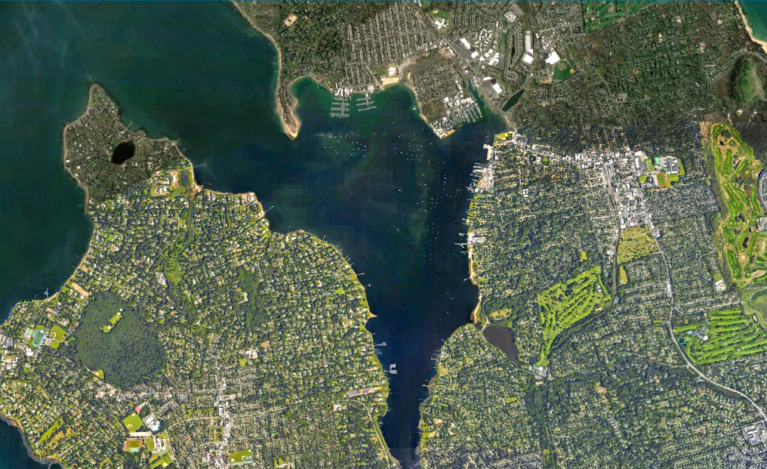
Water quality has improved in Manhasset Bay between the Great Neck and Port Washington peninsulas, according to a new report released by the Manhasset Bay Protection Committee, although its authors urged continued vigilance.
The study, conducted by Fuss & O’Neil, gathered bacterial and water quality data between 2009 and 2015 from six sites in Manhasset Bay, including three in Port Washington, one in the Plandomes, one in Great Neck and one in the heart of the bay.
It was also the first published in nearly 10 years, with the last being published in 2009.
“Over the course of this relatively short sampling period, the range of bacteria concentrations (i.e., the difference between the minimum and maximum count) at most sampling stations decreased, especially since the first few years of the period of record,” the report said.
The study also showed a link between rainfall, sampling location and total bacteria, as well as strong influence by stormwater runoff. The bay is largely “safe to swim in,” the report goes on to say, “just not right after (or during!) a storm.”
According to the report’s spatial summary, elevated bacteria levels are more likely to occur on a rainy day on the Port Washington peninsula because of its storm drains and because the area generally has higher bacteria concentrations.
“However, it is important to note that the majority of samples collected at all stations are below the state standards for safe swimming and over the period of record examined none of the annual median values exceeded the single sample standard for fecal coliform or enterococcus,” the report said.
The Great Neck peninsula, meanwhile, was more likely to see elevated levels after a rainfall.
According to charts in the report, the mean – or average – concentration of fecal coliform at the Plandome sampling station was 76.02 CFU (colony-forming units) per 100 ml, Great Neck’s was 44.47, Manorhaven’s two locations were 80.99 and 126.38, and the station bordering Port Washington North and Baxter Estates rang in at 356.24.
The maximum concentrations measured at each of the stations exceeded state standards, which allow for concentrations of up to 1,000 CFU per 100 ml. The Baxter Estates and Port Washington measurement station had the highest measurement of 12,400, while one of the Manorhaven stations had 4,100 CFU per 100 ml.
“While maximum values exceed the standards at all stations for both fecal indicator bacteria, the mean and median values are below the current state standard for fecal coliform for all stations and for enterococcus at all stations except MB-5,” the report said, referring to the Port North and Baxter station.
State standards allow for concentrations of up to 104 CFU per 100 ml, while the Environmental Protection Agency considers 60 CFU per 100 ml unsafe.
The Port North and Baxter station’s mean measurement was 135.40 with a maximum measurement of 4,700 CFU per 100 ml, the highest of all six stations. One of the Manorhaven stations had the second-highest measurement of 74.23 CFU per 100 ml, with a maximum-recorded measurement of 3900.
Great Neck’s highest measurement was 164 with an average of 9.68, Plandome’s was 1,070 with a mean of 46.71, the bay had a maximum of 147 with a maximum of 11.29, while Manorhaven’s other station peaked at 3,400 with an average of 51.19.
Ultimately, the report recommends DNA “source tracking,” which could lead to a “more targeted program to reduce or even eliminate the source of pollution,” and further investigating the causes of pollution at the sampling stations near Leeds Pond, which is the Plandome station, and Baxter Beach, which is at the station along the border of Baxter Estates and Port Washington North.
The report also advises picking up after pets, not dumping anything into storm drains and not fertilizing lawns before a rainstorm. It also recommends not feeding birds, cleaning up spills and regularly pumping out cesspools and septic tanks.
“Keeping the bay clean is something all of us can help do,” said Town Councilwoman Dina De Giorgio, who represents Port Washington. “Simple tasks, like picking up after pets, not over-fertilizing lawns, and keeping everything but stormwater out of storm trains, will make a big impact on Manhasset Bay.”
The Manhasset Bay Protection Committee’s membership includes Nassau County, the Town of North Hempstead, and the villages of Baxter Estates, Flower Hill, Great Neck, Kensington, Kings Point, Manorhaven, Munsey Park, Plandome, Plandome Heights, Plandom Manor, Port Washington North, Sands Point, and Thomaston.
The full report and its summary can be found online.






